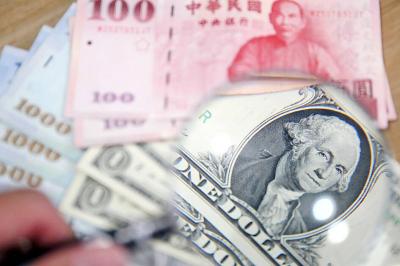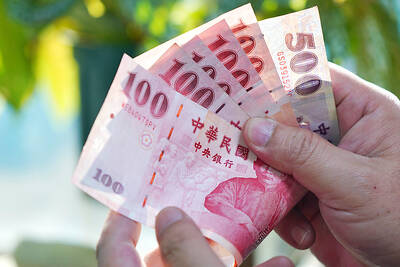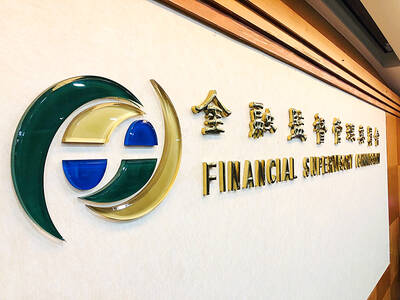Mike Liang earns the equivalent of US$37,500 a year, owns a four-bedroom apartment and can afford to send his two daughters to English tutorial schools.
Like other workers at the Hsinchu Science Park (
But what is on Liang's mind and that of many others is how the high-tech industry can maintain success amid growing competition from neighbors such as South Korea and price declines in products like laptops. The slower growth rate in sales of some high-tech goods and the economic downturn in the US are also worries.
Many industry workers and analysts say the nation's greatest economic challenge is overcoming the reliance on manufacturing for other brands and focusing on innovation and building its own brands.
"We have to transform ourselves," Liang said during a lunch break. "Otherwise, our costs will keep going up and companies will move to China and Vietnam."
High-tech products accounted for 70 percent of the nation's exports last year. Taiwan is the world's largest supplier of notebook PCs and liquid-crystal-display (LCD) panels for flat-screen televisions, the government said.
Two of the world's biggest contract microchip makers are based in Taiwan -- Taiwan Semiconductor Manufacturing Co (台積電) and United Microelectronics Corp (聯電) -- and their foundries, the world's two biggest, are at Hsinchu Science Park, one of the nation's three such parks.
The Hsinchu park opened in December 1980, Southern Taiwan Science Park (
The Hsinchu park is home to 440 companies and is where most of the nation's leading high-tech manufacturers are based.
But profit margins for many of the companies in the park have been narrowing. Some have moved production to China, while others are considering relocation to Vietnam for lower labor and production costs.
"Back in 1999 and 2000, these companies enjoyed quite healthy profit margins," said Cheng Ming-kai (
Revenue growth at Taiwan semiconductor companies, for example, has fallen to single digits from double digits. A main reason is what Cheng calls the "me, too" mentality -- too many companies all doing the same thing.
"A lot of companies think: `If you're going to make something profitable, I'm going to make the same thing slightly less profitable,'" Cheng said.
About 50 percent of the companies in the Hsinchu Science Park carry out semiconductor manufacturing, design or related work, with revenue from the sector comprising 71 percent of the park's total revenue.
Local companies are also largely focused on making products for global brands like Dell, Apple and Intel, instead of coming up with their own brands, and they focus on hardware manufacturing, where only a small percentage of the price the consumer pays for a product is earned.
As little as 5 percent of the consumer price for a product like a laptop can be earned by the Taiwanese companies that assemble them, while a higher percentage -- about 20 percent -- is earned by contract manufacturers that make chips or other parts for the brand holders, industry estimates indicate.
With their own brands, the companies could earn as much as 30 percent of the consumer value of a product, analysts estimate.
Hsinchu Science Park Administration director-general Huang Der-ray (黃得瑞) said companies in the park had increased spending on research and development from 4 percent of total revenue in previous years to 7 percent in the last three years.
Firms have also begun to focus on innovation and building their own brands. Mediatek Inc (聯發科), a chip design company that initially focused on optical storage drivers' chips, has ventured into other areas, including designing chips for wireless communications and high-definition digital televisions. The company is one of the most profitable in the science park and is considered a pioneer in its designs.
Several companies have focused on research into new technologies, including solar energy, Huang said. One, Gintech Energy Corp (昱晶), has been successful in designing solar panels, which it sells to power companies around the world.
More companies are moving toward design. A decade ago, only about 20 or 30 companies in the Hsinchu park were chip design companies, with most being contract manufacturers. Now, there are 80 companies whose focus is design, Huang said.
Workers like Liang, while worried, say they think Taiwan can pull off another economic miracle.
"I'm optimistic," he said, but added: "To compete, Taiwan has to invest a lot of money."

The US dollar was trading at NT$29.7 at 10am today on the Taipei Foreign Exchange, as the New Taiwan dollar gained NT$1.364 from the previous close last week. The NT dollar continued to rise today, after surging 3.07 percent on Friday. After opening at NT$30.91, the NT dollar gained more than NT$1 in just 15 minutes, briefly passing the NT$30 mark. Before the US Department of the Treasury's semi-annual currency report came out, expectations that the NT dollar would keep rising were already building. The NT dollar on Friday closed at NT$31.064, up by NT$0.953 — a 3.07 percent single-day gain. Today,

‘SHORT TERM’: The local currency would likely remain strong in the near term, driven by anticipated US trade pressure, capital inflows and expectations of a US Fed rate cut The US dollar is expected to fall below NT$30 in the near term, as traders anticipate increased pressure from Washington for Taiwan to allow the New Taiwan dollar to appreciate, Cathay United Bank (國泰世華銀行) chief economist Lin Chi-chao (林啟超) said. Following a sharp drop in the greenback against the NT dollar on Friday, Lin told the Central News Agency that the local currency is likely to remain strong in the short term, driven in part by market psychology surrounding anticipated US policy pressure. On Friday, the US dollar fell NT$0.953, or 3.07 percent, closing at NT$31.064 — its lowest level since Jan.

The New Taiwan dollar and Taiwanese stocks surged on signs that trade tensions between the world’s top two economies might start easing and as US tech earnings boosted the outlook of the nation’s semiconductor exports. The NT dollar strengthened as much as 3.8 percent versus the US dollar to 30.815, the biggest intraday gain since January 2011, closing at NT$31.064. The benchmark TAIEX jumped 2.73 percent to outperform the region’s equity gauges. Outlook for global trade improved after China said it is assessing possible trade talks with the US, providing a boost for the nation’s currency and shares. As the NT dollar

The Financial Supervisory Commission (FSC) yesterday met with some of the nation’s largest insurance companies as a skyrocketing New Taiwan dollar piles pressure on their hundreds of billions of dollars in US bond investments. The commission has asked some life insurance firms, among the biggest Asian holders of US debt, to discuss how the rapidly strengthening NT dollar has impacted their operations, people familiar with the matter said. The meeting took place as the NT dollar jumped as much as 5 percent yesterday, its biggest intraday gain in more than three decades. The local currency surged as exporters rushed to